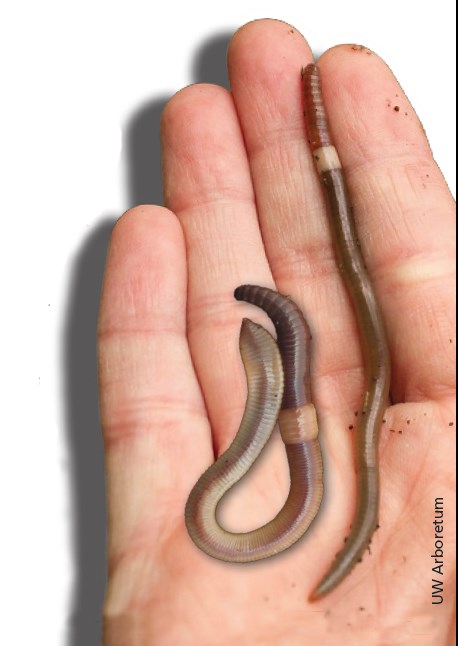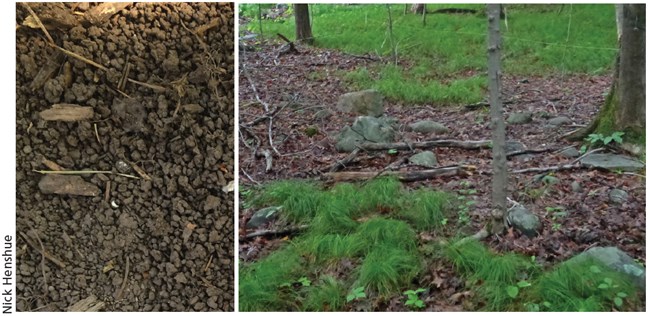Last updated: January 15, 2025
Article
Species Spotlight - Crazy Snakeworm

UW Arboretum
What is it?
You would be forgiven for thinking that something called the Alabama Jumper, Jersey Wriggler, or Crazy Snake-Worm was either some kind of wild new cocktail or amusement park ride, but it is unfortunately something much more sinister than that. A new forest threat has oozed into our region, and it’s literally right under our feet. Worse yet - it is a creature that most of us were raised to believe as being a beneficial presence in our yards and gardens. Indeed that is true of some worm species, but not the crazy snake-worm - an aggressive invasive earthworm with the potential to completely alter the character, functionality, and make-up of northern forests. Introduced from East Asia around 80 years ago, it has since become well established in most southeastern states, and has recently wormed its way into Wisconsin, Illinois, Oregon, and many northeastern states.
Just looking at one you might be hard pressed to tell the difference between it and any other species of earthworm. But try to grab hold of it and you’ll quickly understand the energetic nicknames this worm has earned. They thrash about so wildly they can come clear off the ground. Their locomotion is where “snake” comes in, as they slither from side-to-side to move rather than using the more typical inch worm-like method. You need to YouTube them immediately.
How does NETN monitor it?
NETN’s long-term forest health monitoring program helps to track earthworm invasions and impacts. Each site visit, all forest plots are visually inspected for signs of worm presence or activity (burrows and casts). At this point, worms are not identified to species since monitoring takes place too early in the season to easily distinguish what kind of worms they are, but it is likely that most of what is being seen in plots so far are in the Lumbricidae family (of night crawler fame).
NETN parks vary in degree of earthworm invasion, and there is a decidedly north-to-south gradient with the southernmost parks being most invaded. Morristown NHP in NJ, Saratoga NHP in NY, and Weir Farm NHS in CT are particularly laden with earthworms with 90 to 100% of monitoring plots showing signs of earthworms.
Why is it a problem?
In your garden, as worms decompose organic matter and digest soil they release nutrients making them more available to plants. In addition, their tunneling activity creates pathways for air, water, and plant roots. But it’s when earthworms escape to the forest that things really start to go sour.
There haven’t been native earthworms in the northeast since the last ice sheet pulverized them over 15,000 years ago, and as a result northern forest ecosystems have evolved without them. Their natural decomposers aren’t worms, but fungi and other microflora and fauna that release nutrients slowly over time. All of the 30 or so earthworm species in the region today have been introduced. They are spread from nursery stock, by gardeners sharing plants, improperly discarded fishing bait, and in some commercial mulch and compost. The fisherman’s-favorite “night crawler” earthworm is also a big concern for forests as it too is a big eater, but it is the crazy snake-worm that holds the potential of having the most negative impacts.
European earthworms like the night crawler are hermaphroditic, that is, they possess both male and female organs, though they still need to mate to produce offspring. Snake worms, however, can use “parthenogenetic” reproduction, meaning they create egg cocoons without needing to mate. Mature snake worms create 1-2 eggs with each cocoon, which may not sound like much until you realize a worm can create about 60 of these cocoons in a season and the hatched worms can create cocoons of their own in just a couple months. When hundreds or even thousands of worms hatch at once, you may see a truly Hitchcockian spectacle - what looks like thousands of small filament hairs wriggling across the soil surface.

Nick Hensue
The eggs aren’t even fazed by Northeastern winters - withstanding temperatures as low as -40° F (adult worms usually succumb to the elements by the end of December). European earthworms are mostly active in spring and fall, becoming sluggish during the hottest and driest months of summer. Snake-worms, however, are literally just getting warmed up, and create cocoons from July straight in to November. They mature about twice as fast as their European cousins too, completing two generations per season. All this means that just a single worm can spawn a new infestation in a previously un-invaded space.
Snake-worms live in the top 2 to 4 inches of topsoil and leaf litter. As they devour this “duff” layer it destroys the seed bed critical for tree seedlings and wildflowers. Their population density gets higher than other earthworms as well, and their relatively large size means they can consume more organic matter in less time. They break down organic matter so quickly in fact that the nutrient overload can actually injure plants and/or run off into streams and lakes.
The worms’ castings turn soil into thick layers of loosely connected bits. Seeds cannot get a purchase or keep moist enough to germinate in this “ground beef” soil. Established plants may also die - not only from worms feeding on their roots but from the roots’ exposure to air as a consequence of soil disturbance from the loose layer of castings.
It gets worse - all that tunneling and munching they do also damages an essential relationship for forests. Mycorrhizae are hair-thin threads of fungi that weave together the roots of plants. The fungi helps their host plants siphon nutrients from the soil and they get a sugary food in exchange. Most plants can’t survive without their particular mycorrhizal partner, and when worm activity breaks apart this thin web of sustenance, it can damage or kill the dependent plants.
Following earthworm invasion is a predictable and precipitous decline of understory seedlings and wildflowers, which in turn promotes erosion, deprives ground-nesting birds and salamanders of cover, and forces deer to browse more aggressively on mature saplings. At least a couple NETN parks are likely showing signs of this. The worms even change the very chemistry of the soil. Their gizzards emit calcium carbonate, acting like lime on acid soil and making it more alkaline and less suitable for acid-loving species like azaleas and oaks. When soil changes, effects ripple outward to all parts of an ecosystem. Invaders, like Japanese barberry, stiltgrass, and garlic mustard can get a leg up from the flush of nitrogen, crowding out native plants.
Do You Have Snake-Worms in Your Yard or Forest?
Sometimes all it takes to spot an earthworm invasion is to look at the forest-floor. At the risk of stating the obvious - if you see worms, there’s a problem. Lacking worms themselves, if you see mostly grasses, ferns, jack-in-the-pulpits (which are naturally resistant to earthworm damage) and invasive plants, it is likely they are present. A noticeable lack of leaf litter by mid-to-late summer is also a telltale sign of earthworm invasion.
Another test for worms involves a little kitchen chemistry. Add a spoonful of liquid mustard to a gallon of water and pour it on the ground. This doesn’t harm plants, and worms - of all species - will come to the surface within a few minutes. Look for snake worms by their behavioral cues.
Several different methods are being studied aimed at controlling the spread of these worms - from an organic fertilizer, to biochar, to prescribed burns. For now, if you find them in your yard, the Wisconsin Dept of Natural Resources recommends killing them by bagging as many as you can and putting them out in the sun for at least 10 minutes. Then you can just throw the bag away.
You can do your part to prevent them spreading too. Always check potted plants and trees for worms before planting them in your yard. Examine clothing, gardening, and landscaping materials before doing yard work in a new location to prevent transporting cocoons. If you buy compost, only buy from sources that heat it at appropriate temperatures and duration to kill pathogens.
For parks, NETN recommends cleaning tires on heavy equipment before moving into un-invaded areas to avoid spreading worms.
For more information
Find protocols, reports, and resource briefs on the Forest Health Monitoring webpage .Download a printable PDF of this article.
Tags
- acadia national park
- appalachian national scenic trail
- boston harbor islands national recreation area
- marsh - billings - rockefeller national historical park
- minuteman missile national historic site
- morristown national historical park
- saint-gaudens national historical park
- saratoga national historical park
- saugus iron works national historic site
- weir farm national historical park
- netn
- species spotlight
- worm
- invasive pests
